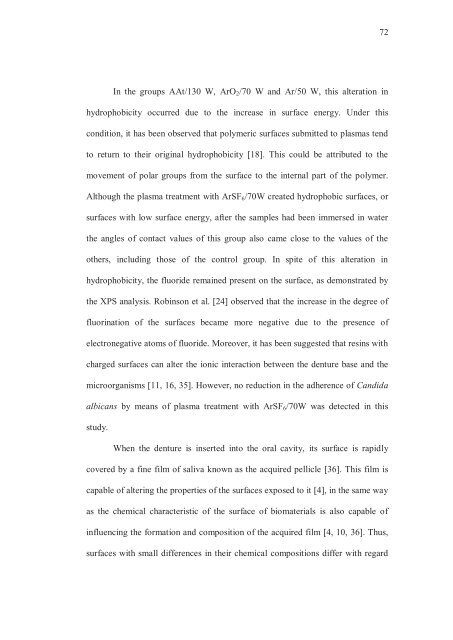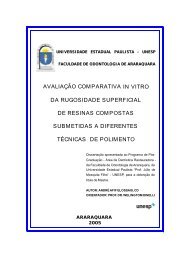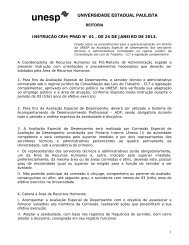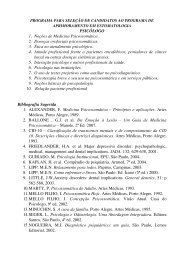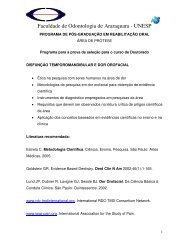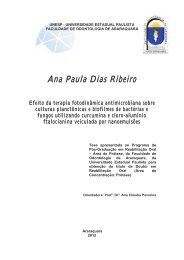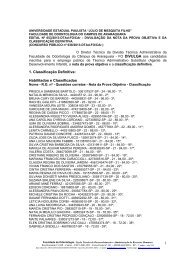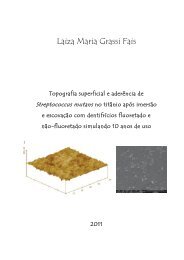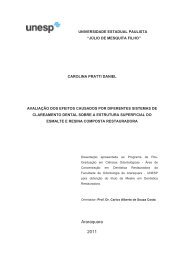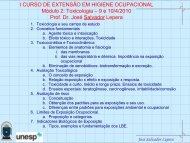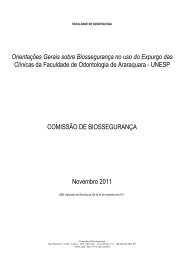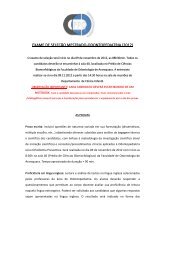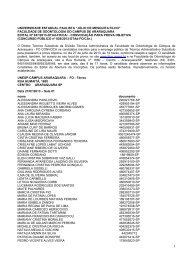universidade de são paulo - Faculdade de Odontologia - Unesp
universidade de são paulo - Faculdade de Odontologia - Unesp
universidade de são paulo - Faculdade de Odontologia - Unesp
Create successful ePaper yourself
Turn your PDF publications into a flip-book with our unique Google optimized e-Paper software.
72<br />
In the groups AAt/130 W, ArO 2 /70 W and Ar/50 W, this alteration in<br />
hydrophobicity occurred due to the increase in surface energy. Un<strong>de</strong>r this<br />
condition, it has been observed that polymeric surfaces submitted to plasmas tend<br />
to return to their original hydrophobicity [18]. This could be attributed to the<br />
movement of polar groups from the surface to the internal part of the polymer.<br />
Although the plasma treatment with ArSF 6 /70W created hydrophobic surfaces, or<br />
surfaces with low surface energy, after the samples had been immersed in water<br />
the angles of contact values of this group also came close to the values of the<br />
others, including those of the control group. In spite of this alteration in<br />
hydrophobicity, the fluori<strong>de</strong> remained present on the surface, as <strong>de</strong>monstrated by<br />
the XPS analysis. Robinson et al. [24] observed that the increase in the <strong>de</strong>gree of<br />
fluorination of the surfaces became more negative due to the presence of<br />
electronegative atoms of fluori<strong>de</strong>. Moreover, it has been suggested that resins with<br />
charged surfaces can alter the ionic interaction between the <strong>de</strong>nture base and the<br />
microorganisms [11, 16, 35]. However, no reduction in the adherence of Candida<br />
albicans by means of plasma treatment with ArSF 6 /70W was <strong>de</strong>tected in this<br />
study.<br />
When the <strong>de</strong>nture is inserted into the oral cavity, its surface is rapidly<br />
covered by a fine film of saliva known as the acquired pellicle [36]. This film is<br />
capable of altering the properties of the surfaces exposed to it [4], in the same way<br />
as the chemical characteristic of the surface of biomaterials is also capable of<br />
influencing the formation and composition of the acquired film [4, 10, 36]. Thus,<br />
surfaces with small differences in their chemical compositions differ with regard


